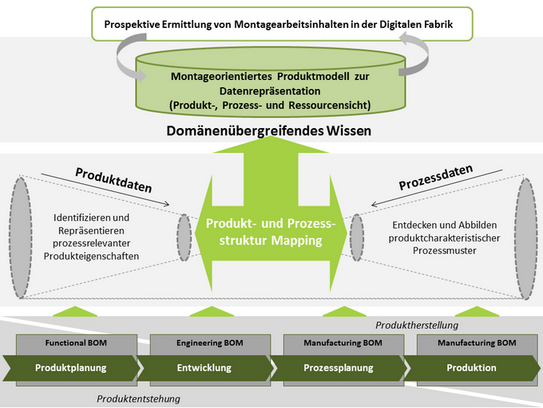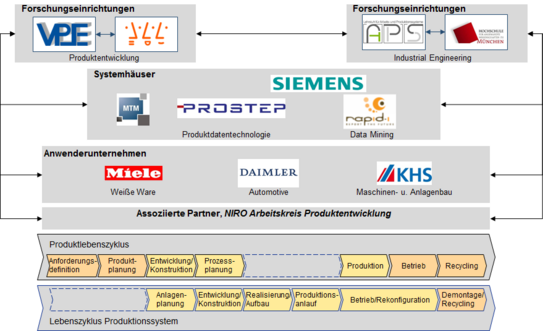Pro Mondi
Prospective Determination of Assembly Work Content in the Digital Factory (Pro Mondi)
(Project duration: March 2012 to February 2015)
Problem
Increasing product and process complexity as well as growing cost and time pressure are presenting manufacturing companies in Germany with ever greater challenges. To meet these challenges, production companies are increasingly using digital planning tools for product and process planning. The integration of the early phase of product development with production system development and in particular with process planning has been identified by industry as an essential part of optimising product creation and a central aspect of the innovation process.
At present, however, there is a lack of practicable approaches for carrying out this integration with little effort and on a solid data basis, even though the digital factory and the continuous use of IT tools in all phases of product creation that it aims to achieve are becoming increasingly important and are already being used by a large number of manufacturing companies. Due to the lack of consistent use and mapping of development-relevant and mostly isolated data, the potential of the digital factory for improving planning quality and standardising planning processes with the highest possible reuse of planning results, including in the area of assembly, has not yet been fully exploited.
Objective
The aim of the research project is to develop a method for the prospective determination of assembly work content in an early phase of the product development process (PDP). The solution pursued here is based on a combination of the research fields of product data technology, the digital factory, data mining and time management in order to make cross-domain planning knowledge from different PDP phases available along the product creation process. The result is an IT-supported method that uses an assembly work content-specific mapping of existing product and process structures. By classifying and allocating new types of products on this basis according to the similarity principle, a low-effort, sufficiently precise determination of the assembly work content is to be made possible in an early phase of product creation on the basis of existing planning data.

As a basis for the desired product and process structure mapping, it is first necessary to discover and map product-characteristic process patterns that serve to determine assembly work contents within the scope of an analysis of the process data using unsupervised learning methods. The process data required for this are taken from different planning systems and prepared in a uniform manner. In a further analysis step, those product properties are identified that have a significant influence on the characteristics of the corresponding process patterns and can therefore be classified as process-relevant. These properties can then be used by design-support systems as a basis for creating assembly templates. By evaluating these templates, process-relevant product properties are stored in the extended product data model and made uniformly available to the subsequent process planning systems for further processing. In this way, with knowledge of the existing links between the process-relevant product properties of existing products and their distinctive product-characteristic process patterns, the basis can be created for a prospective determination of assembly work contents for new types of products.
The prospective determination of future assembly work contents is thus carried out with efficient, methodical use of the available database of previous product and process planning and leads to stochastic results with a minimum confidence interval. The processing of the input data is independent of the underlying product and process structures. Furthermore, it is only with the use of modern structure-discovering and structure-mapping methods that the evaluation of the incomplete and error-laden information characteristic of early phases of the PDP becomes possible.
Procedure
The joint project is designed to run for three years. The objective of developing a method for the prospective determination of assembly work content in the digital factory is being worked on in several work packages. To identify the influence of product characteristics on assembly work content, a comprehensive analysis will first be carried out in close cooperation between the Chair of VPE and the Faculty of Mechanical and Process Engineering at the University of Applied Sciences Augsburg, the Faculty of Precision and Micro Engineering, Physical Engineering at the University of Applied Sciences Munich and the Chair of APS. In addition to the identification of these characteristic product features, their suitable linkage with the process structures is also an open research question. The development of a suitable method for evaluating and processing the often incomplete and erroneous data is being led by Rapid-I and supported by the scientific institutions.

These will primarily contribute the results from the investigation into the influence of the product properties on the assembly work content. Furthermore, the implementation of the developed tools as well as large parts of the requirements specification and validation will take place in close cooperation between the system providers (Siemens PLM and MTM Softwarehaus) and the user companies Daimler Trucks, KHS and Miele. Based on its many years of experience with the development of DIN EN ISO 10303 application protocols, PROSTEP AG will be involved in providing input for standardisation activities and requirements specification for product and process modelling.
For the successful solution of the tasks in the project, the division of labour between the partners in the joint project will take place according to the core competences. The form of interdisciplinarity along the product life cycle from product development (mainly represented by the Chair of VPE and the University of Applied Sciences Augsburg) to industrial engineering before SOP (mainly represented by the Chair of APS and the University of Applied Sciences Munich) to production operation (at Daimler Trucks, KHS and Miele, among others) appears to be particularly advantageous for the successful processing of the research project. Cross-PEP software and method development will be led by scientific institutions as well as Siemens PLM, MTM, PROSTEP and Rapid-I.
Research- and Development Partner
- Siemens Industry Software GmbH & Co. KG (consortium leader)
- Daimler AG
- Deutsche MTM-Gesellschaft mbH Software House
- Faculty of Precision Engineering and Microtechnology, Physical Engineering, University of Applied Sciences Munich
- Faculty of Mechanical and Process Engineering, Augsburg University of Applied Sciences
- KHS GmbH
- Chair of Virtual Product Development, TU Kaiserslautern
- Miele & Cie KG
- PROSTEP AG
- Rapid-I GmbH
Funding Reference
This research and development project is funded by the Federal Ministry of Education and Research within the framework concept "Research for the Production of Tomorrow" and is supervised by the Project Management Agency Karlsruhe. The responsibility for the content of this publication lies with the author.


![[Translate to English:] [Translate to English:]](/storages/zentraler_bilderpool/_processed_/2/6/csm_Altes_Maschinenbau-Gebaeude_3a1a87015a.jpg)